Formula, Example Solved Problems | Mensuration | Maths - Surface Area of Cuboid and Cube | 9th Maths : UNIT 7 : Mensuration
Chapter: 9th Maths : UNIT 7 : Mensuration
Surface Area of Cuboid and Cube
Surface Area of Cuboid and Cube
We have learnt
in the earlier classes about 3-Dimension structures. The 3D shapes are those which
do not lie completely in a plane. Any 3D shape has dimensions namely length, breadth
and height.
1. Cuboid and its Surface Area
Cuboid: A cuboid is a closed solid figure bounded by six rectangular plane regions. For example,
match box, Brick, Book.
A cuboid
has 6 faces, 12 edges and 8 vertices. Ultimately, a cuboid has the shape of a rectangular
box.
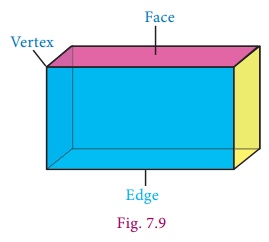
Total Surface Area (TSA) of a cuboid is the sum of the areas of all the faces that enclose the cuboid. If we leave out the areas of the top and bottom of the cuboid we get what is known as its Lateral Surface Area (LSA).
In the Fig
7.10, l, b and h represents length, breadth and height respectively.
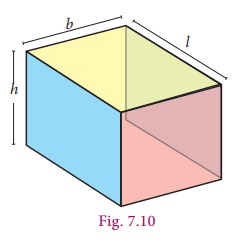
(i) Total
Surface Area (TSA) of a cuboid

= 2 (lb + bh + lh ) sq. units.
(ii) Lateral
Surface Area (LSA) of a cuboid

= 2 (l+b)h sq. units.
We are using
the concept of Lateral Surface Area (LSA) and Total Surface Area (TSA) in real life
situations. For instance a room can be cuboidal in shape that has different length,
breadth and height. If we require to find areas of only the walls of a room, avoiding
floor and ceiling then we can use LSA. However if we want to find the surface area
of the whole room then we have to calculate the TSA.
If the length, breadth and height of a cuboid are l, b
and h respectively. Then
(i) Total Surface Area = 2 (lb + bh + lh ) sq.units.
(ii) Lateral Surface Area = 2 (l+b)h sq.units.
Note
ŌĆó The top and bottom area in a cuboid is independent of height. The
total area of top and bottom is 2lb. Hence LSA is obtained by removing 2lb
from 2(lb+bh+lh).
ŌĆó The units of length, breadth and height should be same while calculating
surface area of the cuboid.
Example 7.4
Find the
TSA and LSA of a cuboid whose length, breadth and height are 7.5 m, 3 m
and 5 m respectively.
Solution
Given the
dimensions of the cuboid;
that is length
(l) = 7.5 m, breadth (b) = 3 m and height (h)
= 5 m.
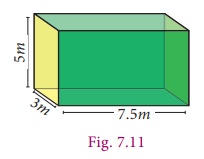
TSA =
2(lb + bh + lh)
= 2[(7.5 ├Ś 3) + (3 ├Ś 5) + (7.5 ├Ś 5)]
= 2(22.5 +15 + 37.5)
= 2├Ś75
= 150 m2
LSA =
2(l + b) ├Ś h
=2(7.5+3)├Ś5
=2├Ś10.5├Ś5
= 105 m2
Example 7.5
The length,
breadth and height of a hall are 25 m, 15 m and 5 m respectively.
Find the cost of renovating its floor and four walls at the rate of Ōé╣80 per m2.
Solution
Here, length
(l ) = 25 m, breadth (b) =15 m, height (h) =
5 m.
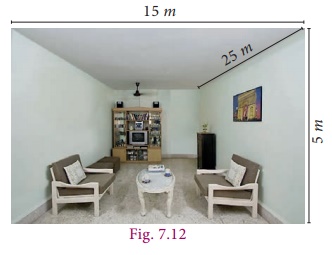
Area of four
walls = LSA of cuboid
= 2(l
+
b) ├Ś h
= 2(25
+15)
├Ś
5
= 80
├Ś
5 =
400 m2
Area of the floor = l ├Ś b
= 25 ├Ś15
= 375 m2
Total renovating
area of the hall
= (Area of
four walls + Area of the floor)
= (400 + 375) m2
= 775 m2
Therefore,
cost of renovating at the rate of Ōé╣80 per m2 =
80 ├Ś
775
= Ōé╣ 62,000
2. Cube and its Surface Area
Cube: A cuboid whose length, breadth and height are all equal is called as
a cube.
That is a
cube is a solid having six square faces. Here are some real-life examples.
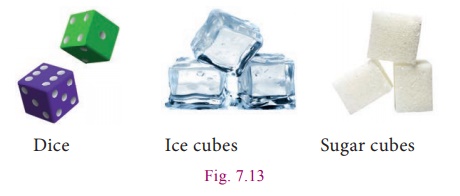
A cube being
a cuboid has 6 faces, 12 edges and 8 vertices.
Consider
a cube whose sides are ŌĆśaŌĆÖ units as shown in the Fig 7.14. Now,
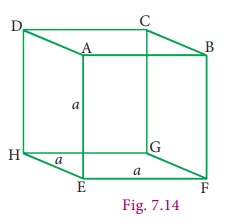
(i)
Total Surface Area of the cube
= sum
of area of the faces (ABCD+EFGH+AEHD+BFGC+ABFE+CDHG)
= (a
2 + a 2 + a 2 +
a 2 + a 2 +
a2 )
= 6a2
sq. units
(ii)
Lateral Surface Area of the cube
= sum
of area of the faces (AEHD+BFGC+ABFE+CDHG)
= (a
2 + a 2 + a 2 +
a2 )
= 4a2
sq. units
If the side of a cube is a units, then,
(i) The Total Surface Area = 6a2 sq.units
(ii) The Lateral Surface Area = 4a2 sq.units
Thinking Corner: Can you get these
formulae from the corresponding formula of Cuboid?
Example 7.6
Find the
Total Surface Area and Lateral Surface Area of the cube, whose side is 5 cm.
Solution
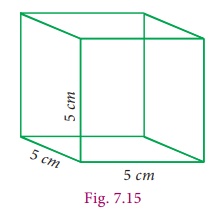
The side
of the cube (a) = 5 cm
Total Surface
Area = 6a2 = 6(52 ) = 150 sq.
cm
Lateral Surface
Area = 4a2 = 4(52 ) = 100 sq.
cm
Example 7.7
A cube has
the Total Surface Area of 486 cm2. Find its lateral surface area.
Solution
Here, Total
Surface Area of the cube = 486 cm2
6a2
=
486
ŌćÆ a2 = 486/6 and so, a2 = 81 . This gives a = 9.
The side
of the cube = 9 cm
Lateral Surface
Area =
4a2 = 4 ├Ś 92 = 4 ├Ś 81 = 324 cm2
Example 7.8
Two identical
cubes of side 7 cm are joined end to end. Find the Total and Lateral surface
area of the new resulting cuboid.
Solution
Side of a
cube = 7 cm
Now length
of the resulting cuboid (l) = 7+7 =14 cm
Breadth (b)
= 7 cm, Height (h) = 7 cm
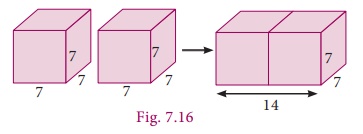
So, Total
Surface Area = 2(lb + bh +
lh)
= 2 [(14├Ś7)+(7├Ś7)+(14├Ś7)]
= 2(98 + 49 + 98)
=2├Ś245
= 490 cm2
Lateral Surface
Area =
2(l + b) ├Ś h
= 2(14+7)├Ś7
=2├Ś21├Ś7
= 294 cm2
Related Topics